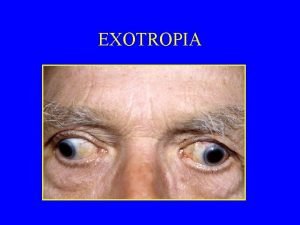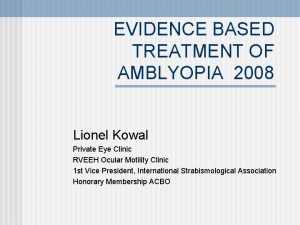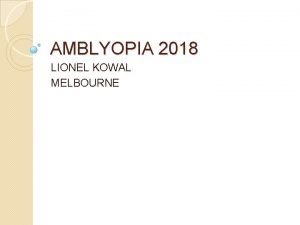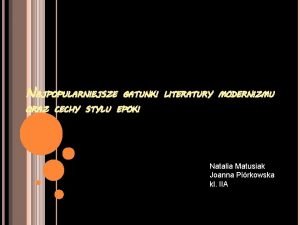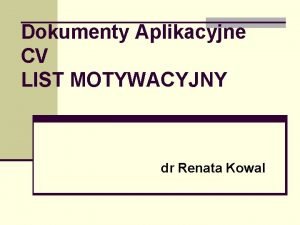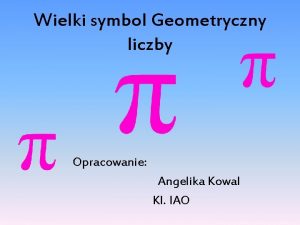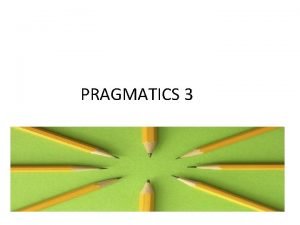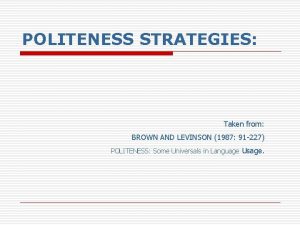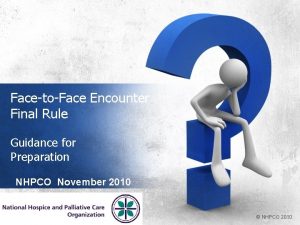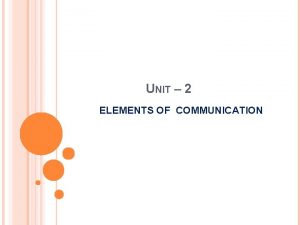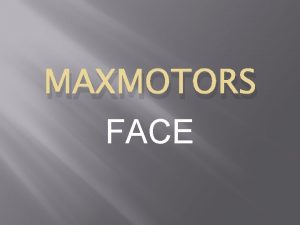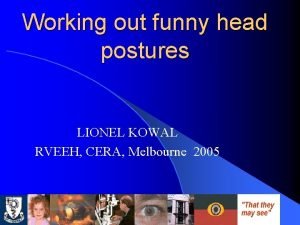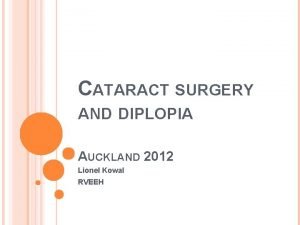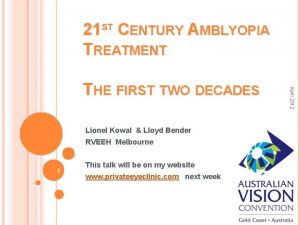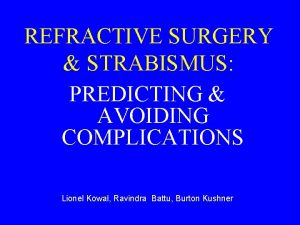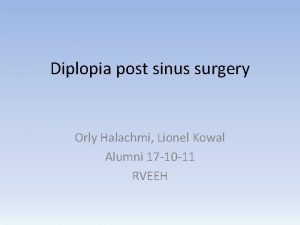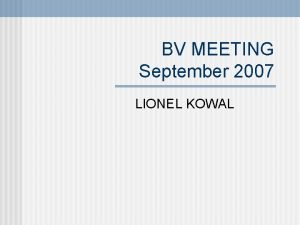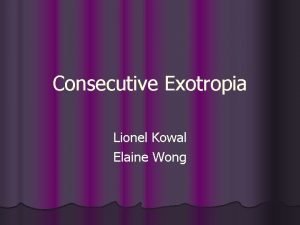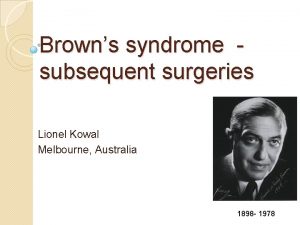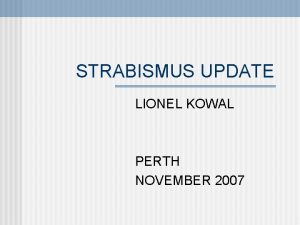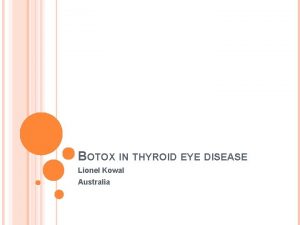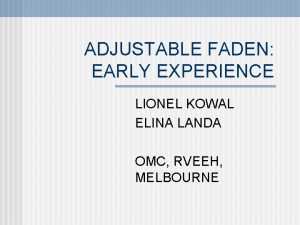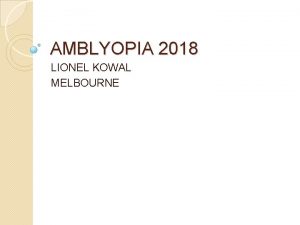Working out head tilts face turns LIONEL KOWAL




















- Slides: 20

Working out head tilts & face turns LIONEL KOWAL RANZCO SQUINT CLUB Dunedin 2005

Q 1: Is HT driven by visual activity? Instruction to patient: Close your eyes and hold your head straight. l Uncertain: pt closes eyes, Dr tilts head randomly, pt asked to straighten head

Both eyes closed HT persists l HT not related to visual activity! l Causes: Eyes closed Vestibular problem / ocular tilt reaction / tectal pathology/ neck problems

BE closed - HT goes l HT l driven by visual activity Now determine: Is HT driven by – Right eye fixing RF – Left eye fixing LF – Either eye fixing EE – Only when both eyes are fixing BE

Either eye drives HT l Congenital nystagmus with oblique null l Look for other features of CN to confirm l De Decker or Sousa Dias for treatment guidelines

Special case: Head tilt to fixing eye l LF l 2 drives HT to L causes: l 1. Torsional null for LMLN l 2. L Orbital reasons

LF drives HT to L 1. Torsional LMLN l Seen in cong ET l Can see fine torsional N on slit lamp l N degrades vision - vision improves when N blocked

LF drives HT to L 1. Torsional LMLN l Preference for fixation in intorsion HT to fixing eye recruits SO which acts as a ‘brake’ for [& is a null for] torsional component of the LMLN l Usually the dominant eye but can be the ‘wrong’ eye

Special case: Alternating Head Tilt l LF drives L tilt l RF drives R tilt l= Ciancia’s syndrome

Ciancia’s syndrome l Head tilt / face turn recruits a muscle to block the torsional / horizontal component of LMLN improves vision l T: HT to fixing eye - recruits Sup Obl to ‘brake’ T LMLN l H: FT to fixing eye - recruits Medial Rectus to ‘brake’ H LMLN

LF drives HT L 2. Orbital reason Orbital scarring l Restrictive strabismus esp Graves’ l Motor reasons l Sensory reasons - acquired astigmatism from tight muscles l

HT driven by binocularity l RF = LF = no HT l Strabismus l Tilt the cause R and do a cover test to discover the cause!

RF Head Tilt to L Problem with R orbit

Face Turn - L l Approach the same way as tilt - a few differences l Is the FT visually driven: “Close your eyes and hold your head straight” l If it’s visually driven, is it driven by: l LF RF EE BE ?

Face Turn - Left l l l If driven by: LF : Fixation- in- adduction for horizontal LMLN or L orbital problem RF : R orbital problem EE : cong nystagmus BE : strabismus

Alternating Face Turn 2 causes 1. Ciancia’s syndrome l LF : L FT l RF : R FT l Ciancia’s syndrome: preference for fixation in adduction because [probably] recruiting medial rectus ‘brakes’ horizontal component of LMLN improved vision

Alternating Face Turn 2. Periodic alternating nystagmus l ‘Regular’ CN with 2 null zones l Much more frequent than suspected esp albinism l CAREFUL FAT SCAN : ANY photos showing FT R suggest PAN

Alternating Face Turn 2. Periodic alternating nystagmus Usually asymmetric periodicity = ‘aperiodic’ say, 90% FT L, 10% FT R l Prolonged in- office exam l

Astigmatism l Wrong cyl axis can head tilt l Uncorrected astigmatism : pt uses corner of palpebral fissure to act as ‘pinhole’

Working out head tilts & face turns THANK YOU
 Dr lionel kowal
Dr lionel kowal Dr kowal ophthalmologist
Dr kowal ophthalmologist Dr lionel kowal
Dr lionel kowal Lionel kowal
Lionel kowal One direction metaphors
One direction metaphors Witold kowal ue wroc
Witold kowal ue wroc Jak wygląda kowal
Jak wygląda kowal Dramat cechy
Dramat cechy Dostarcz list do kowala
Dostarcz list do kowala Agata kowal
Agata kowal Rozwinięcie liczby pi
Rozwinięcie liczby pi Caroline kowal
Caroline kowal Smart work vs hard work
Smart work vs hard work Hot working of metals is carried out
Hot working of metals is carried out Hot working and cold working difference
Hot working and cold working difference Differentiate between hot working and cold working
Differentiate between hot working and cold working Proses pembentukan logam
Proses pembentukan logam High considerateness style
High considerateness style Positive face and negative face examples
Positive face and negative face examples Face-to-face narrative examples
Face-to-face narrative examples Site:slidetodoc.com
Site:slidetodoc.com
